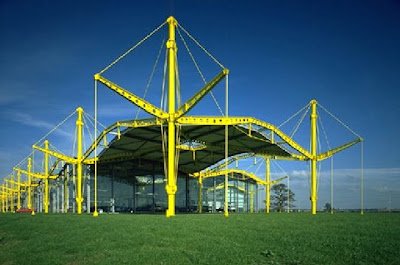
High-technology (usually contracted to “high-tech”) architecture was a movement born in the 1960s and sustained through the 1980s. It sought to express zeitgeist—the spirit of the age—defined by its followers as resting in the technological advances of industry, communications, and travel, including aerospace developments. These advances offered an alternative building approach. “High-tech” architects produced machinelike structures of flexible plan, applying lightweight materials such as sheet metal, glass, and plastic to innovative structural techniques; they employed easily assembled, sometimes mass-produced, building components. Usually, the structure was made explicit (often reinforced by colorful paintwork). Sometimes the services were exposed. Constructed between 1980 and 1983, the Renault Distribution Center at Swindon, about 100 miles (160 kilometers) southwest of London, was and continues to be regarded as the archetypal high-tech building.
The brief called for a building that established a progressive corporate identity and stood out from the featureless industrial shed typical of the area. It was to suit multiple functions, be quickly constructed, and capable of later extension. Architect Norman Foster of Foster Associates, together with the engineering firm of Ove Arup and Partners, responded with a design for a visually arresting, structurally self-explicit building that dominated what has been described as an otherwise bleak landscape.
Foster was born in 1935 in Manchester, England. He trained as an architect and town planner at the University of Manchester (1956–1961) before undertaking a master’s degree in architecture at Yale University (1961–1962). Soon after, following a brief period with Richard Buckminster Fuller, he returned to England to set up practice with his wife Wendy and Richard and-Su Rogers. They worked as Team 4 between 1964 and 1967 until the partnership was superseded by Foster Associates, now Foster and Partners. In the late 1960s Foster and Richard Rogers made a significant architectural statement at Swindon with the Reliance Controls Factory (1967), one of the last Team 4 projects. Its elegance, use of off-the-shelf components, exposed steel structural bracing, metal cladding, wall-high glazing, flexible plan, and focus on improved employee working conditions all challenged the conventional wisdom about industrial buildings. Reliance Controls was an early example of high tech.
Almost two decades later the Swindon landscape was again confronted—this time by the unconventional form of the Renault Center. Brilliant yellow (Renault’s corporate color) cable-stayed tubular steel masts supported a reinforced polyvinyl chloride (PVC) membrane roof that covered spaces for spare parts warehousing, visitor reception, distribution and regional offices, vehicle showroom, after-sales maintenance training, and staff dining. Its expressive, detailed outline and functional, worker-friendly spatial arrangements were characteristically Fosteresque, balancing the high-tech approach with client and social needs. In its marketing literature, Renault enthusiastically reproduced images of its marqueelike center, regarding it as the quintessence of its corporate image.
When presented with plans for the sloping 16-acre (6.5-hectare) site, the local authority consented enthusiastically to the unexpected design and to the proposed 67 percent land coverage (the usual limit was 50 percent). The prefabricated rectangular building was formed as a series of suspended modules—forty-two in total—comprising 52-foot-high (16-meter) masts, connected to pin-jointed portal frames. Each module measured 91 feet (24 meters) square and was 25 feet (7.5 meters) high at the edge and 31 feet (9.5 meters) in the center. As extensions were required, modules could be unbolted and new ones added. Initially, thirty-six modules were devoted to warehousing, the rest located at the narrower end of the site where the building tapered to a generous entry and porte cochere.
The fully exposed, repetitive mast arrangement flowed graciously beyond the external walls, glazed for showroom and dining but sealed elsewhere with steel skins. Ample natural lighting was achieved by clear glass panels inserted where the mast pierced the roof membrane and by a louvered roof light at the apex of each module; the louvers could be opened for ventilation. The building was centrally heated and lit according to the function of the space. Foster Associates designed the furniture.
The Renault Distribution Center has been described as ushering in the firm’s Hong Kong and Shanghai Bank headquarters (1979–1986) in Hong Kong, also noted for its extrinsic structural expression. However, unlike the sprawling Renault building, the bank headquarters is a soaring triple-layered tower (the tallest forty-one stories) with immense tubular steel trusses from which the floors are suspended. Many consider tins Foster’s magnum opus.
Hi Omkar,
ReplyDeleteThis is Fershteh from Iran,
your blog was very helpful to me,
Thank you, wish you luck